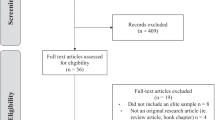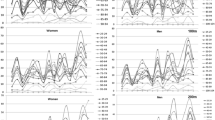Abstract
In breaststroke, at each arm action corresponds one leg kick; therefore, compared to the other strokes (front crawl, backstroke and butterfly), the contribution of the lower limbs is more important. However, it can be observed that the same distance can be covered at similar velocities with different stroke length (SL) and, as a consequence, stroke rate (SR). Hence, it seems that breaststroke swimmers can use different styles to achieve their goals. Therefore, the assessment of upper and lower limbs strength becomes very important along with the style being used during breaststroke performance. Twenty-four male and twenty female national-level breaststroke swimmers were divided in two groups for each gender, according to their SR (low-SR and high-SR). They performed 100 m breaststroke all-out performance in a 50 m swimming pool. SR, SL and velocity (v) were measured. To assess upper and lower limbs strength, swimmers underwent dry-land chin-up and jump & reach tests. Dry-land tests did not correlate to v (p > 0.05). SL inversely correlated to chin-up and directly correlated to jump & reach (p < 0.01). Regardless to the gender, low-SR had lower chin-up results than high-SR (males 0.19 ± 0.03 vs. 0.24 ± 0.04 nr kg−1, p < 0.01; females 0.13 ± 0.02 vs. 0.15 ± 0.03 nr kg−1, p < 0.05) and jumped higher than high-SR (males 31.74 ± 0.50 vs. 25.11 ± 0.55 % height, p < 0.001; females 22.93 ± 0.33 vs. 20.54 ± 0.63 % height, p < 0.01) swimmers. Despite many factors are involved in determining swimming performance, upper and lower limbs strength seems to be linked to a different breaststroke style in our group of swimmers.

Similar content being viewed by others
References
D’Acquisto LJ, Costill DL, Gehlsen GM, Young WT, Lee G (1988) Breaststroke economy, skill, and performance: study of breaststroke mechanics using a computer based “velocity-video” system. J Swim Res 4:9–13
Craig AB, Pendergast DR (1979) Relationships of stroke rate, distance per stroke, and velocity in competitive swimming. Med Sci Sports 11:278–283
Mousavi SH, Bahadoran MR (2011) Investigation of arm and leg contribution to propulsion and percentage of coordination in breaststroke swimming. Int J Acad Res Bus Soc Sci 1:400–407
Shahbazi-Moghadam M (2008) Determination of arms and legs contribution to propulsion and percentage of coordination in breaststroke swim. In: ISBS-conference proceedings, pp 58–61
Van Tilborgh L, Willems EJW, Persyn U (1988) Estimation of breaststroke propulsion and resistance resultant impulses from film analysis. In: Ungerechts B, Wilke K, Reischle K (eds) Swimming science V. Human Kinetics, Champaign, pp 67–72
Seifert L, Chollet D (2005) A new index of flat breaststroke propulsion: a comparison of elite men and women. J Sports Sci 23:309–320
Chollet D, Seifert L, Leblanc H, Boulesteix L, Carter M (2004) Evaluation of arm-leg coordination in flat breaststroke. Int J Sports Med 25:486–495
Haljand R (2012) LEN swimming competition analysis. http://www.swim.ee/competition/index.html. Accessed 19 July 2013
Potdevin FJ, Alberty ME, Chevutschi A, Pelayo P, Sidney MC (2011) Effects of a 6-week plyometric training program on performances in pubescent swimmers. J Strength Cond Res 25:80–86
West DJ, Owen NJ, Cunningham DJ, Cook CJ, Kilduff LP (2011) Strength and power predictors of swimming starts in international sprint swimmers. J Strength Cond Res 25:950–955
Deschodt VJ, Arsac LM, Rouard AH (1999) Relative contribution of arms and legs in humans to propulsion in 25-m sprint front-crawl swimming. Eur J Appl Physiol Occup Physiol 80:192–199
Schleihauf RE (1979) A hydrodynamic analysis of swimming propulsion. In: Terauds J, Bedingfield E (eds) Swimming III. University Park Press, Baltimore, pp 70–109
Atkinson G, Nevill AM (1998) Statistical methods for assessing measurement error (reliability) in variables relevant to sports medicine. Sports Med 26:217–238
Strass D (1988) Effects of maximal strength training on sprint performance of competitive swimmers. In: Ungerechts B, Wilke K, Reischle K (eds) Swimming science V. Human Kinetics, Champaign IL, pp 149–156
Aspenes ST, Karlsen T (2012) Exercise-training intervention studies in competitive swimming. Sports Med 42:527–543
Girold S, Jalab C, Bernard O, Carette P, Kemoun G, Dugue B (2012) Dry-land strength training vs. electrical stimulation in sprint swimming performance. J Strength Cond Res 26:497–505
Chatard J, Mujika I (1999) Training load and performance in swimming. In: Keskinen KL, Komi PV, Hollander AP (eds) Biomechanics and medicine in swimming VIII. University of Jyvaskyla, Jyvaskyla, pp 429–434
Capaci K, Ozcaldiran B, Durmaz B (2002) Musculoskeletal pain in elite competitive male swimmers. Pain Clin 14:229–234
Ruwe PA, Pink M, Jobe FW, Perry J, Scovazzo ML (1994) The normal and the painful shoulders during the breaststroke. Electromyographic and cinematographic analysis of twelve muscles. Am J Sports Med 22:789–796
Nuber GW, Jobe FW, Perry J, Moynes DR, Antonelli D (1986) Fine wire electromyography analysis of muscles of the shoulder during swimming. Am J Sports Med 14:7–11
Markovic G, Dizdar D, Jukic I, Cardinale M (2004) Reliability and factorial validity of squat and countermovement jump tests. J Strength Cond Res 18:551–555
Signorile JF, Zink AJ, Szwed SP (2002) A comparative electromyographical investigation of muscle utilization patterns using various hand positions during the lat pull-down. J Strength Cond Res 16:539–546
Youdas JW, Amundson CL, Cicero KS, Hahn JJ, Harezlak DT, Hollman JH (2010) Surface electromyographic activation patterns and elbow joint motion during a pull-up, chin-up, or perfect-pullup rotational exercise. J Strength Cond Res 24:3404–3414
Thompson KG, Haljand R, MacLaren DP (2000) An analysis of selected kinematic variables in national and elite male and female 100-m and 200-m breaststroke swimmers. J Sports Sci 18:421–431
Persyn UJJ, Hoeven RGC, Daly DJ (1979) An evaluation procedure for competitive swimmers. In: Terauds J, Bedingfield E (eds) Swimming III. University Park Press, Baltimore, pp 182–195
Clarys JP (2003) Electromyograpy of the frontcrawl, for discriminating training methods and re-modelling the arm-motion. In: Pelayo P, Sidney M (eds) Actes des 3èmes Journées spécialisées de natation. Lille, 19 et 20 juin 2003. Publibook, Paris, pp 27–40
Figueiredo P, Rouard A, Vilas-Boas JP, Fernandes RJ (2013) Upper- and lower-limb muscular fatigue during the 200-m front crawl. Appl Physiol Nutr Metab 38:716–724
Toussaint HM (1990) Differences in propelling efficiency between competitive and triathlon swimmers. Med Sci Sports Exerc 22:409–415
Morouco P, Keskinen KL, Vilas-Boas JP, Fernandes RJ (2011) Relationship between tethered forces and the four swimming techniques performance. J Appl Biomech 27:161–169
Leblanc H, Seifert L, Chollet D (2009) Arm-leg coordination in recreational and competitive breaststroke swimmers. J Sci Med Sport 12:352–356
Seifert L, Chollet D (2009) Modelling spatial-temporal and coordinative parameters in swimming. J Sci Med Sport 12:495–499
Seifert L, Leblanc H, Chollet D, Delignieres D (2010) Inter-limb coordination in swimming: effect of speed and skill level. Hum Mov Sci 29:103–113
Seifert L, Leblanc H, Herault R, Komar J, Button C, Chollet D (2011) Inter-individual variability in the upper-lower limb breaststroke coordination. Hum Mov Sci 30:550–565
Barbosa TM, Morouco PG, Jesus S et al (2013) The interaction between intra-cyclic variation of the velocity and mean swimming velocity in young competitive swimmers. Int J Sports Med 34:123–130
Acknowledgments
This research was supported by local funds made available by the Department of Biomedical Sciences for Health, Università degli Studi di Milano, Italy.
Conflict of interest
The authors disclose no conflicts of interest.
Author information
Authors and Affiliations
Corresponding author
Rights and permissions
About this article
Cite this article
Invernizzi, P.L., Scurati, R., Longo, S. et al. Relationships between swimming style and dry-land strength in breaststroke. Sport Sci Health 10, 11–16 (2014). https://doi.org/10.1007/s11332-013-0165-6
Received:
Accepted:
Published:
Issue Date:
DOI: https://doi.org/10.1007/s11332-013-0165-6




